Things you would find in my bathroom this morning: a large fan sitting at chest height and pointing toward the floor; a box of one-gallon Zip-lock freezer bags; my daughter’s florescent green plastic sled; the folding, metal fireplace screen from the living room; several gallons of moist dirt–just on the red side of brown. The dirt is spread several inches thick in the bottom of the sled and the combination looks disturbingly like a human-sized kitty box. The fan blows red dust and opened plastic bags across the tile floor. The dust patterns up on the floor into pleasant little dunes. The bags are just annoying. The fireplace screen served well as a soil sifter and gave the whole process a mild archaeological feel, but I may have stained the thing orange. Thank God I chose to do this while my wife was out of town. My daughter is not impressed.
Several weeks ago I had agreed to find red earth for an art project: not just any art project, mind you, but one being completed by my life-long hero and inspiration, Bob Sacamano. I won’t explain the design here because I’m guessing he wants to keep things under wraps, but suffice to say that when Bob asks for red dirt I say “yes, Mr. Sacamano, how much and how red?”
“Two gallons,” was the answer, “and as red as possible.”
Well, that’s easy as pie across most of the Unite States, especially in the iron-rich unglaciated soils of the Mid-Atlantic and Southeast. But here in Maine, the clays are all what as known as the Presumpscot Formation and, although they turn a red when fired, they are a beautiful, creamy grey and not useful for this project. There are mineral rich soils that are stained red by high iron content bedrock up north near the Katahdin Iron Works. But the snow is waist deep up there. And the six mile road to the site is unplowed. And the ground is frozen solid.
But we’re talking Bob Sacamano here: I would climb Lhotse burdened with pick-axe and shovel to get the red earth he needed. But the rub with the red earth near Katahdin is that it’s Red Earth–with caps. It’s sacred. The Wabanaki tribes in the region trace their origins back to the “red paint” people and the red paint in question is the red ochre-rich soils near the sacred mountain itself, Mt. Katahdin. I think I could have worked with the tribal authorities to get permission to dig and collet some soil, but the time, the need for respect, and the extreme weather made that location off limits from my point of view.
“Well, it can certainly be a ‘brownish red,'” Bob said. OK, honestly, Bob did not say that to me–it was George, one of Bob’s assistants–but in my head and whenever I tell the story, it was an order or a compromise directly from the man himself. I scoured my own humble island, Mt. Desert Island. I did find some earth just barely on the reddish side of brown, but it was in Acadia National Park and, although I could very easily have made a collection under the cover of darkness, the health of the Park is just too important to me and COA’s relationship with ANP is something also sacred. Getting caught in the act would not have been good at all for my job security and, like the Katahdin example, could tarnish the project with a very poor color choice.
So I went to the specialist–Dr. Sarah Hall. Sarah explained that this region once had deep red clays put down by the erosion of iron-rich granites of the northern Appalachian range, but that that red clay had been scraped away by the advancing Wisconsin glacier some 15,000 years ago. You find the clays south of the moraines–the humps of earth that mark the end of the advancing glaciers. Yes, there are iron- and mineral-rich soils elsewhere here in Maine, but those deposits are spotty and usually covered by a thick layer of brown to black soils.
But all hope is not lost, Sarah explains. There are a number of magma chambers in our neck of the woods that have left accessible deposits of mineral-rich earth and that earth tends to be on the redder side of brown. For best results in understanding the concept of a magma chamber, you need to speak with Sarah or look beyond my description here–it’s not an intuitive concept.
But try this: Picture really, really hot magma coming up from the mantle. It’s so friggin’ hot that it melts anything in its path as it works its way toward the Earth’s surface. Eventually it hits a temperature and pressure threshold (cooler and less pressure) where it doesn’t have the same “humph” and the magma-inspired tunneling stalls out. Then something else happens and your left with a pile of mineral-rich ores very near the surface. Something like that.
Oftentimes these collapsed magma chambers are dense with valuable metals like Nickel or Cobalt and one such collapsed chamber just so happens to be about two hours south of us, not covered by snow, very accessible by foot, and was designated by the State of Maine as an open prospecting site.
Sarah and I hit the road, armed with all kinds of digging implements, plenty of hunter orange (the only thing one can hunt in early March are crows, snowshoe hare, and coyote–but one cannot be too cautious), and longitude and latitude numbers extending way right of the decimal. There’s no way I would have found this place without Sarah and her longitudes and latitudes.

Selfie of me and Sarah Hall
We are in the earliest stages of Maine’s fifth season, mud season, wedged between winter and spring. Par for the course, the ground was in the process of thawing and the mud was thick and, thankfully, not dissimilar to the orange we wore to avoid getting confused for a coyote, crow, or snowshoe hare.
Sarah helped clarify the magma chamber a bit on the short walk. Don’t think “chamber” as in “cave.” The magma, because of incredible heat and pressure gradients, works its way through a path of least resistance until it gets stuck and then piles up and begins to cool. The magma cuts and fills the chamber simultaneously. As things cool, some of the heaviest minerals begin to sink toward the bottom of the magma blob. When the mass solidifies, you get your igneous rock with the heaviest metals (like Nickel and Cobalt all nicely gathered at the bottom later to be scooped up by some mining company–only, of course, after the top layers are eroded way by water, wind, glaciers, and time. We were on the floor of one of these exposed magma chambers.

Crack open one of these stones and you see the exposed Nickel. Exposed to air, it oxidizes into a purple.

A panoramic of the collection zone.

That’s me breaking through the frozen soil.
We got the reddest stuff we could find, I promise. It definitely has a yellow tinge to it–that comes from the sulfur, according to Sarah. This area was abandoned as a mine for the higher sulfur content of the area, which means you’re left with a lot of sulphur pollution to clean up after you have gathered your Nickel or Cobalt.
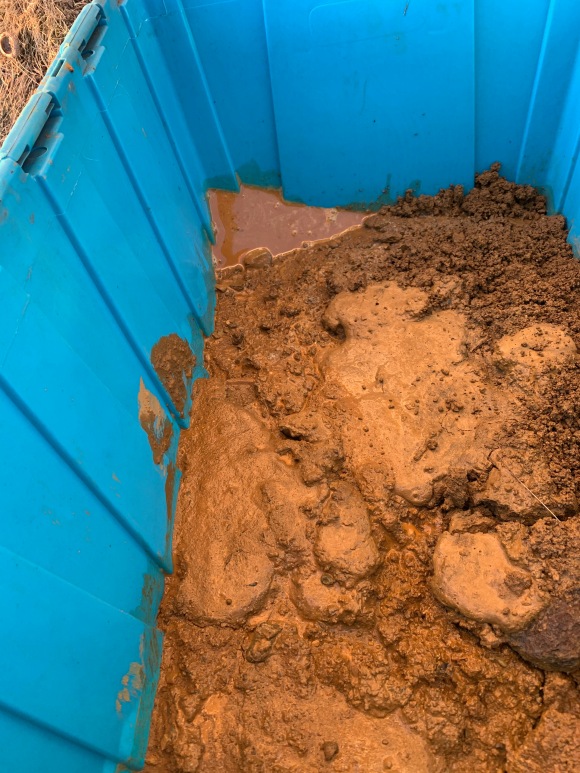
That’s the raw material for what we’re going to send to Andy.
Not too much more to talk about in terms of our collection. Sarah and I, now painted orange by the Earth itself, managed to grab a really nice lunch at Long Grain restaurant in Camden and tracked a good amount of the orange through the restaurant–sorry about that, LG.
But there was no way I was going to send Bob that slop, wet and full of debris. I had to get him two gallons of purity.
Sarah suggested using the COA botany lab with its sieves and ovens for working such material, but I didn’t want to interrupt the flow of work during the last week of term.
Sorting through the cold, wet soil on a cold day was, well, cold–so I brought everything inside and into the sunniest room on the first floor, the bathroom. The sledding has been lame this year on the coast, so I saw no harm in borrowing my daughter Molly’s green sled.

Stage 1 in the green sled. I think I’m going to have to replace the colander.
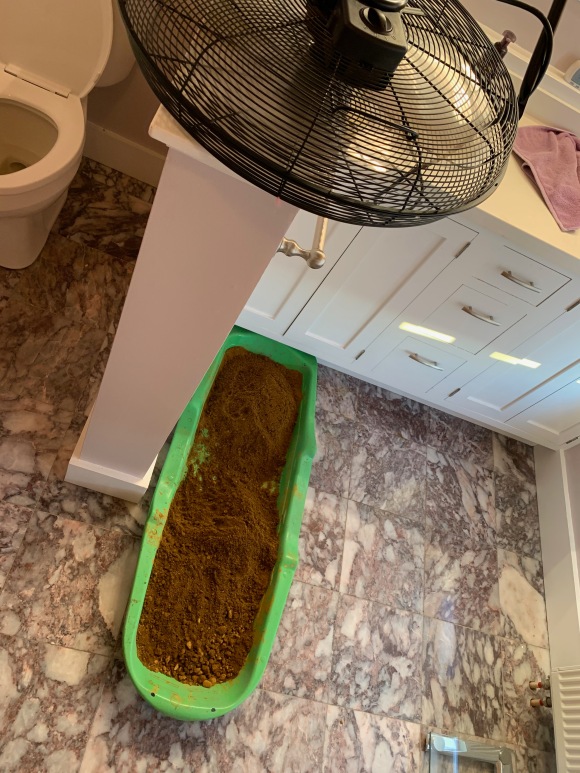
Trying to work with the slop was a disaster. But an afternoon of heat and wind made the material a lot easier to work with.
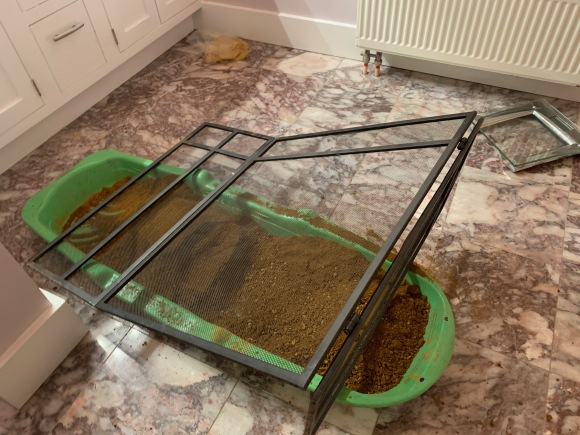
The colander was a disaster–especially when the stuff was still wet. The fireplace screen was perfect. I thought for sure I’d discover a bone or coin or pot sherd in the material–no such luck. It still felt archaeological.

Sifting through the clean, dry material with bare hands was very satisfying. A gallon ziplock never looks like a gallon … until you fill it. I had just the right amount of material.
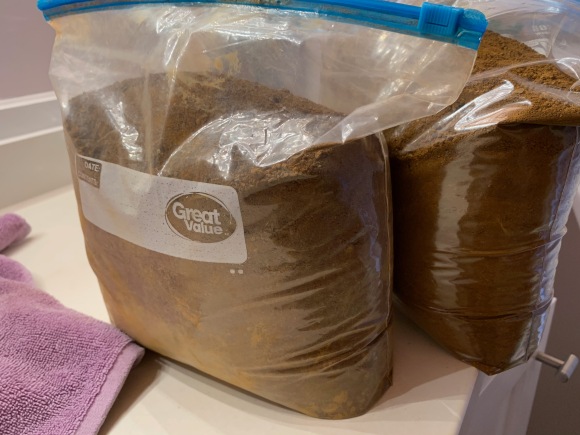
Great value, indeed. Double bagging was a bit of a challenge.
So, that’s it. Well, not exactly. One of the best parts of this project is that it lingers.
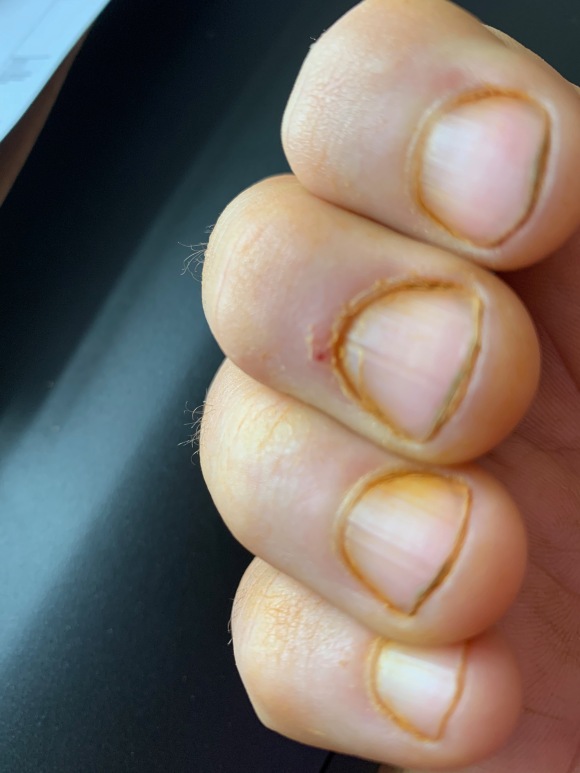
At a board meeting, a trustee said, “What’s going on with your fingers?”
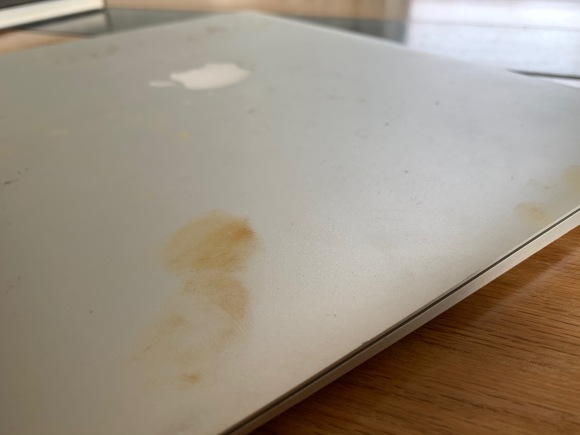
It lingers on my computer.

It lingers, with surprising resilience, in the kitchen sink.

It lingered for a long time on the bathroom floor (looking a lot like a line of red cocaine neatened up by some gangster’s credit card). My bathroom smelled like Yellowstone National Park for some time–the sulphur.

And it lingers in my office at College of the Atlantic, on my well-worn copy of a book in my office.
As with everything Sacamano touches, this project will be something truly extraordinary. I’m honored to have had my fingers in it and my fingerprints on it, even if they’re in and on it at the very margins.

OH MY GOD ANDY GOLDSWORTHY!!! You have to tell us more.